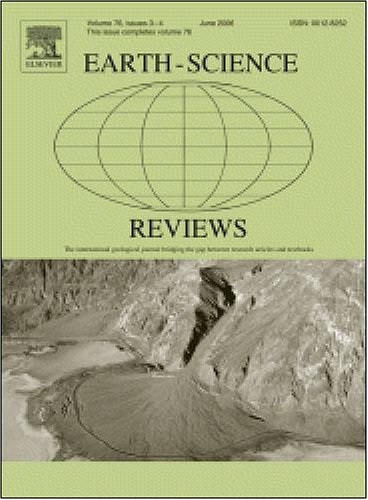Insights from dynamics, mechanisms, factors and mitigation strategies of salt precipitation for CO2 geo-storage within saline aquifer
IF 10
1区 地球科学
Q1 GEOSCIENCES, MULTIDISCIPLINARY
引用次数: 0
Abstract
CO2 geo-storage in saline aquifers offers significant potential for reducing greenhouse gas emissions. However, salt precipitation resulting from mineral crystallization during gas-liquid percolation affects CO2 injectivity and storage efficiency. This review synthesizes recent field data, experiments, numerical simulations, and theoretical studies to identify knowledge gaps and improve understanding. It provides insights into the dynamics, mechanisms, factors, and mitigation strategies of salt precipitation for CO₂ geo-storage in saline aquifers. Field data indicate that salt precipitation mainly occurs within 10–30 m of the wellbore, reducing absolute permeability by 60–70 %. Experimental and numerical studies suggest that capillary-driven drying leads to significant pore blockage near the wellbore, while diffusion- or evaporation-driven mechanisms cause more evenly distributed precipitation. Despite a decrease in absolute permeability, CO2 relative permeability may increase by 5–6 times. Two major challenges contribute to discrepancies between theoretical models and field data: the migration behavior of salt crystallization and dynamic evaporation of the brine. Addressing these challenges requires high-temperature, high-pressure microchip experiments to visualize and quantify brine evaporation dynamics and salt precipitation at the pore scale. Additionally, core flooding tests, coupled with real-time CT/MRI imaging and particle flow simulations, are essential for investigating the interaction between salt precipitation and pore structure damage. Despite the significant impact of reservoir characteristics, brine properties, and injection strategies on salt precipitation dynamics, systematic studies remain limited, and current research is fragmented. This review proposes a comprehensive evaluation framework incorporating multi-factor coupling to better assess salt precipitation risks and improve CO₂ storage efficiency. These findings provide a foundation for managing salt precipitation in subsurface engineering, with broader implications for energy extraction and carbon storage.

从盐降水的动力学、机制、因素和减缓战略对含盐含水层内CO2地质储存的见解
含盐含水层中的二氧化碳地质储存为减少温室气体排放提供了巨大的潜力。然而,气液渗流过程中矿物结晶产生的盐沉淀会影响CO2的注入率和储层效率。这篇综述综合了最近的现场数据、实验、数值模拟和理论研究,以确定知识差距并提高理解。它提供了对含盐含水层CO₂地质储存的盐降水动力学、机制、因素和缓解策略的见解。现场数据表明,盐沉淀主要发生在距井筒10-30米范围内,使绝对渗透率降低60 - 70%。实验和数值研究表明,毛细管驱动的干燥会导致井筒附近明显的孔隙堵塞,而扩散或蒸发驱动的机制会导致更均匀分布的降水。尽管绝对渗透率降低,但CO2的相对渗透率可能增加5-6倍。两大挑战导致理论模型与现场数据之间存在差异:盐结晶的运移行为和盐水的动态蒸发。解决这些挑战需要高温高压微芯片实验来可视化和量化孔隙尺度上的盐水蒸发动力学和盐沉淀。此外,岩心驱油试验、实时CT/MRI成像和颗粒流模拟对于研究盐沉淀与孔隙结构破坏之间的相互作用至关重要。尽管储层特征、盐水性质和注入策略对盐沉淀动力学有重大影响,但系统研究仍然有限,目前的研究也很零散。为了更好地评价盐降水风险,提高CO₂储存效率,本文提出了一个多因素耦合的综合评价框架。这些发现为地下工程中的盐沉淀管理提供了基础,对能源提取和碳储存具有更广泛的意义。
本文章由计算机程序翻译,如有差异,请以英文原文为准。
求助全文
约1分钟内获得全文
求助全文
来源期刊

Earth-Science Reviews
地学-地球科学综合
CiteScore
21.70
自引率
5.80%
发文量
294
审稿时长
15.1 weeks
期刊介绍:
Covering a much wider field than the usual specialist journals, Earth Science Reviews publishes review articles dealing with all aspects of Earth Sciences, and is an important vehicle for allowing readers to see their particular interest related to the Earth Sciences as a whole.
 求助内容:
求助内容: 应助结果提醒方式:
应助结果提醒方式:


